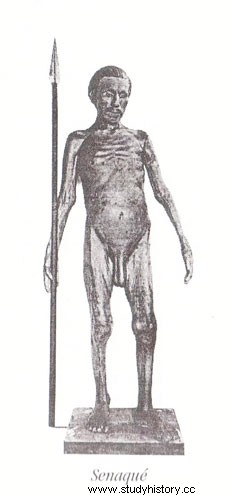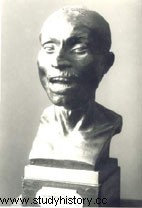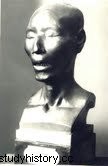Monday, February 25, 1833, Port of Montevideo
The boat leaves the old wooden dock, with the last load of passengers and luggage. With the stroke of oars she crosses the calm waters of the bay towards the French brick Phaeton , anchored a short distance from the coast. Among the passengers, Françoise De Curel , a French ex-military man who had set up a teaching center in Montevideo; consigned as luggage, four charrúas: the chief Vaimaca Peru, the shaman Senaqué, the young warrior Tacuabé and his wife, Guyunusa, a few months pregnant .
Almost two years earlier, the four had arrived in Montevideo as prisoners, after the Salsipuedes massacre . A short time later, De Curel began the negotiations so that the president of the young republic, General Fructuoso Rivera who had engineered the extermination of the Charrúa nation, hand them over to take them to France. De Curel maintained that his objectives were purely scientific, although the reality was different. Rivera, in fact, did not care; De Curel offered him a good excuse to get rid of them, he gave him his authorization by drafting a hypocritical statement stating that the Charrúas were traveling with him voluntarily and that they were willing to stay with him in Paris for a while, in exchange for It will provide them with the necessary means for their subsistence.
Tuesday May 7, 1833, Port of Saint-Malo, France
The Phaeton touch port after almost seventy days of crossing. The four “specimens ” huddle on the wooden pier, haggard and frightened, while their French “owner” makes the necessary arrangements to move them to Paris. Once there, he has brochures printed promoting the arrival in France of “…four individuals who offer living models of physical construction and moral characters[…] They represent the true types of the third race of men, the race coppery ”. The novice speculator of the spectacle rents a house at 19, Rue Chaussé D’Antin where the unusual “exposure ” opens to the public on June 19, from 3:00 p.m. to 6:00 p.m. Attendees had to pay 5 francs to see the “savages ”, although the low turnout forces De Curel to lower the entrance fee to only 2 francs per person.
Friday, July 12, 1833, Paris
After almost a month of being exhibited as “curious objects ” Brought from wild America, the Charrúas are subjected to an unusual experiment, this time by the Academy of Moral Sciences . Several musicians from the Paris Conservatory Orchestra give a concert in full view of the four exiles for academics to “study ” his reaction to the music, as if it were exotic animals. To everyone's surprise, the “savages ” show great sensitivity to the piece performed, especially to the wind instruments. In particular, they are the two older men, Senaqué and Vaimaca , who come out of their normal apathy and react more visibly to the melody.
However, other studies to which they were subjected were not as delicate, nor were their conclusions as "humane". One of them, which consisted of taking the physical measurements of the four charrúas, concluded that the skulls of the natives had the same measurements as those of many guillotined criminals in France. Scientific method, they called it.
Sunday July 22, 1833, Paris
Senaqué , the oldest of the four, the “man who heals ”, The shaman of his clan, has spent the last few days facing the wall, in a corner, complaining in his rustic Spanish:“ Poor Senaqué, poor Senaqué ”. It's been days since he's had a bite to eat and he's getting weaker little by little. The academics of the Museum of Natural History decide to intern him in a sanatorium to try to recover his health. The money necessary for this will come from the fund for the “treatment of rare animals ”. But everything is useless. Devastated by sadness and anguish, overwhelmed by confinement and weakened by fasting, the old man from Uruguay dies on July 26, just over 5 months after being uprooted from his land. The Natural History Museum takes over his body:his internal organs are removed for study, some of which end up being embalmed. With his skin a “ moulage is built ” life-size, filled with straw, although its features are “Europeanized ”:hair is placed shorter and neatly combed back, and some ridiculous mustaches are added without taking into account that the charrúas were hairless. Such a work of art is cataloged with the number N-673 . Neither this infamous mannequin, nor any of Senaqué's embalmed organs ever left the museum basements to be displayed in the museum's display cases. Today, there is no trace of them.

Moulage de Senaque
Friday, September 13, 1833, Paris
The chief Vaimaca Peru he outlived his companion barely a month and a half, and died consumed by the same evils that took his old friend. His remains suffered a fate similar to that of Senaqué. As soon as he was dead, a plaster cast of his skull was made, based on which a bust was made with great fidelity in terms of the features. The rest of his body is the subject of various studies and analyses; different pieces of his skin are used for a very important study: determine the number of sebaceous glands and hair follicles he had! The skull, meanwhile, is trepanned and then sawed to study the brain. His skeleton was preserved and was later loaned to the Museum of Man in Paris .

Vaimaca
Friday, September 20, 1833, Paris
In front of a large crowd of onlookers and doctors, who came to watch the delivery as if it were a rare spectacle, Guyunusa , aided by Tacuabé , gives birth to their daughter. There are indications that they could have called her Micaela . The chair birth – squatting – so common among many indigenous ethnic groups, had no setbacks and the little charrúa joined her parents in her unworthy exile. Amazed, the attendees verify that the crying of the newborn “is in every way similar to that of our children ”. But public opinion was going to play its part in this drama. At first, the Parisians saw the show put on by De Curel as a simple curiosity from overseas. But as the charrúas died, and the details of their confinement became known, indignation gradually gained space for curiosity. The protests grew and worsened, until De Curel was reported to the Police and fled from Paris... but not only.
With his “merchandise ”On his back, De Curel travels to his hometown, Lyon, where he quickly gets rid of the charrúas by selling them to a circus businessman who incorporates them into his show. For promotional purposes, he changes his name to Tacuabé, calling him Jean Soulasol , “the Hercules of Hercules ”
Tuesday July 22, 1834
However, business was not for the circus man. Shortly after arriving in Lyon, Guyunusa she dies of tuberculosis at the Hotel Dieu Hospital in Lyon. In her case, they did not wait for her to die to shave her head and cast her head in plaster. The resulting bust is even more vivid than that of Vaimaca . Her body was buried in a common grave. After the death of her companion, the young Tacuabé she manages to run away from the circus, taking his little ten-month-old daughter with her. From there the trace of him is lost, and the speculations about his fate are fundamentally two:
The first states that Tacuabé and the little girl, lacking natural defenses against the disease, must have contracted the tuberculosis that killed Guyunusa, and would have died shortly after.
The second, perhaps more romantic, says that Tacuabé, an eminent horse tamer, he could have made a living in rural France, surviving with his daughter.

Guyunasa
In 1950, a small article appeared in a Lyon newspaper, maintaining that a family living in the area claimed to have Charrúa ancestors. Currently, there is still a street in that city that is known by the name of “Camino del Indio ”, and popular legend maintains that it is called that way because once an Indian was seen walking along that path, carrying a little girl in his arms.
Continue…. The repatriation of the last charrúa (in collaboration with Pablo Petrides )
